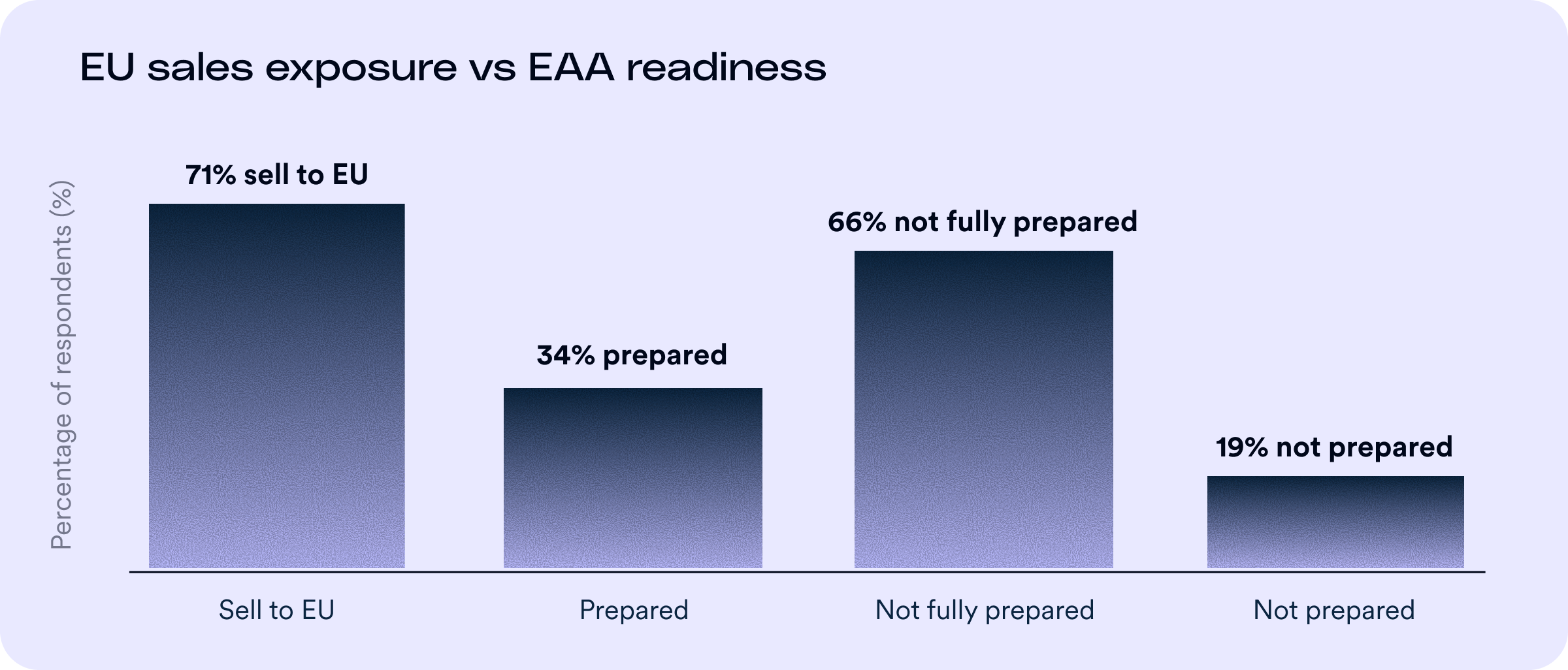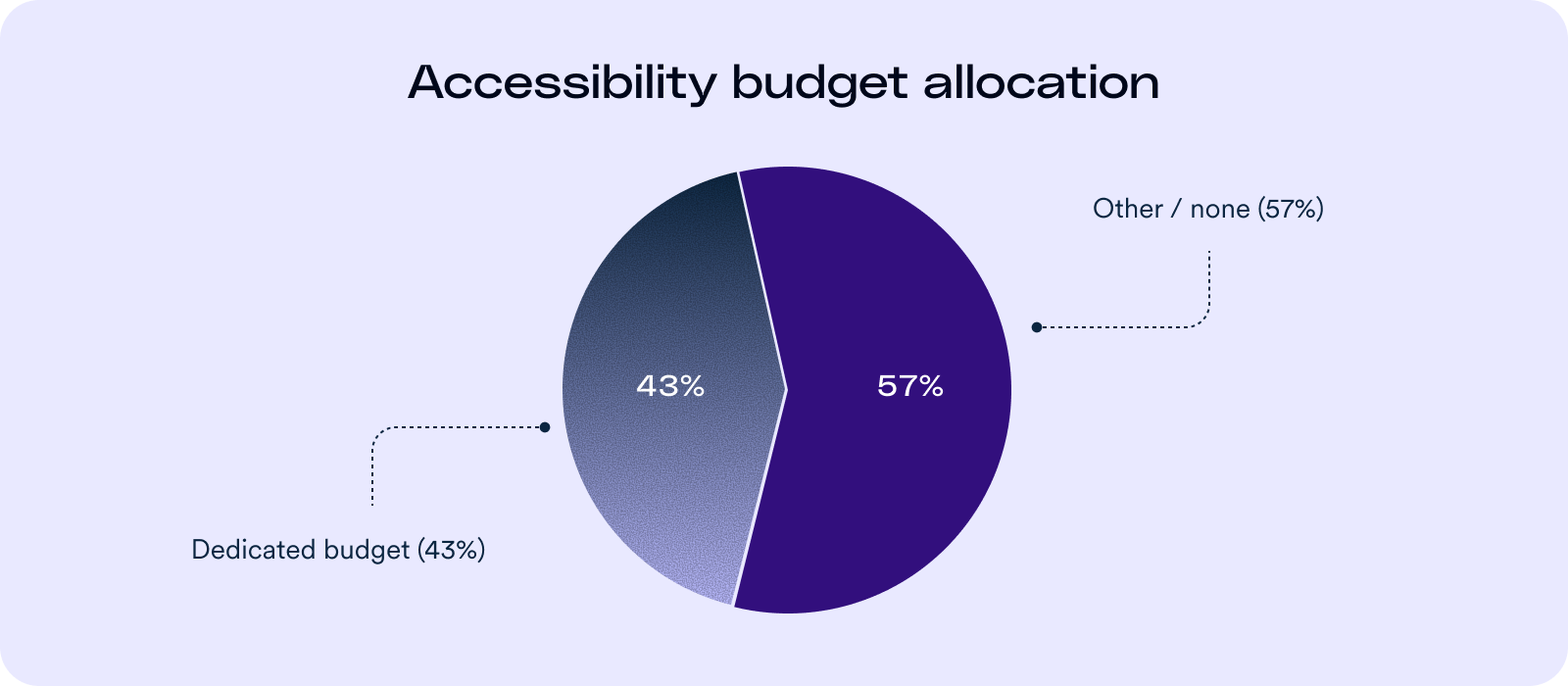About the research
Our eCommerce trends survey—conducted with Qualtrics, non-profit leaders, and disability community organizations—captured insights from over 300 eCommerce leaders and members of the disability community. The findings show that while most retailers recognize accessibility’s role in compliance, too many remain unprepared for the European Accessibility Act (EAA) and UK Equality Act, underscoring why accessibility-by-design is increasingly recognized as the sustainable standard for eCommerce.
Compliance goes global and eComm is in the spotlight
Accessibility is no longer a regional concern—it’s a global mandate. The EAA has brought Europe into alignment with a growing wave of accessibility regulation, while the UK’s Equality Act continues to require “reasonable adjustments” in digital services.
For eCommerce brands, this creates both urgency and opportunity. Retail websites are uniquely complex—frequent catalog updates, dynamic filters, third-party plug-ins, and high-stakes checkout flows all raise the risk of breaking compliance.
Accessibility can’t be an afterthought. Now that EAA enforcement is active in 2025, any business selling into the EU must meet WCAG 2.1 AA standards, while the UK Equality Act 2010 remains firmly in place. Regulators are already acting: Germany fined a retailer €150,000 for checkout alt-text failures, with penalties climbing as high as €500,000 per violation.
For eCommerce leaders, compliance has become the foundation of customer trust and market access.

Compliance pressure meets consumer expectation
Accessibility has become both a legal requirement and a commercial necessity for any brand selling into Europe. With the European Accessibility Act (EAA) now enforceable and the UK Equality Act 2010 still in effect, regulators are raising the bar and retailers are under scrutiny.
Key developments shaping 2025:
- Europe’s enforcement milestone: The EAA took effect on June 28, 2025, requiring all businesses selling digital products and services into the EU to comply with WCAG 2.1 AA standards via EN 301 549. It applies broadly—from marketplaces and streaming platforms to banking and ticketing—but eCommerce sits at the center of attention.
- UK’s parallel obligations: The Equality Act requires “reasonable adjustments” for digital services, meaning UK retailers already face strict expectations. Those selling into the EU must comply with both frameworks, raising the stakes further.
Escalating penalties: In Germany, fines can reach €500,000 per violation, with one retailer fined €150,000 in 2025 for missing alt-text in checkout. In the UK, the EHRC can issue unlawful act notices, injunctions, and pursue reputationally damaging enforcement actions.
For eCommerce, the pressure is amplified:
- Dynamic environments: Filters, carousels, pop-ups, and third-party plug-ins often break assistive technologies
- Frequent changes: Seasonal catalogs, promotions, and product updates can create recurring compliance gaps
- Shifting expectations: Customers increasingly see accessibility as a marker of trust, alongside sustainability and security
Compliance with the EAA and UK Equality Act is essential for success in the competitive eCommerce space. For retailers, accessibility-by-design is the only sustainable way to avoid fines, protect customer trust, and keep pace with competitors already investing.
Designing for compliance and inclusion
Strict enforcement is only half the story. It’s also important to consider how accessibility shows up in day-to-day retail operations. For eCommerce sites, compliance isn’t won or lost in abstract policies, but in the details of checkout flows, product filters, carousels, and promotions.
Accessibility can’t always be patched in later—not in retail, and not under the strict enforcement climate of 2025.
Retail sites are constantly changing, and quick fixes may not hold up through seasonal updates or third-party plug-ins. Retrofitting is also more expensive, harder to maintain, and leaves technical debt behind. Most importantly, last-minute patches don’t deliver the smooth, reliable experience that customers, and regulators, now expect.
Compounding the challenge, just 43% of companies have a dedicated accessibility budget, leaving most teams under-resourced for a regulation that could affect their revenue streams.

Building accessibility in from the start avoids the costly cycle of break → patch → break again. It also makes compliance more affordable, keeps experiences stable across updates, and ensures inclusive design works seamlessly for every shopper.
The benefits of accessibility-by-design are unmistakable.
- Lower long-term cost: Addressing accessibility during design and development is significantly cheaper than retrofitting fixes after launch
- Sustainable compliance: Integrated coding practices and continuous audits reduce exposure to fines and create documentation regulators recognize as good faith
- Inclusive customer journeys: Labeled forms, alt text on product images, and logical focus orders make shopping flows usable for everyone
- Stronger brand trust: Public accessibility statements and inclusive design choices signal reliability to both customers and regulators
- Revenue impact: Accessible checkouts reduce abandonment, improve loyalty, and translate compliance directly into performance gains
Meanwhile, the risks of ignoring accessibility in today’s legal climate are steep.
- Regulatory penalties: With fines up to €500,000 per violation, common gaps like checkout failures can carry heavy consequences
- Unstable fixes: Patches tied to seasonal updates or third-party code often break, creating recurring compliance gaps
- Broken journeys: Pop-ups, modals, and carousels without proper markup trap users and cause abandonment
- Reputational damage: In 2025, exclusion is visible and judged harshly, leaving brands behind more inclusive competitors
Accessibility isn’t just about avoiding fines, but rather it’s the strategy that makes eCommerce compliant, reliable, and scalable. By combining automated testing with manual remediation, retailers can prove due diligence to regulators and deliver seamless shopping experiences to every customer.
"Accessibility is about creating a welcoming, usable experience for all customers; it builds loyalty, improves usability for everyone, and should be baked into every update, not treated as a checkbox." - The Arc of South Carolina |
Navigating the new compliance landscape
- Build accessibility in from the start
Accessibility-by-design is the only sustainable path forward. Embedding WCAG standards into design and development cycles reduces long-term costs, prevents recurring compliance gaps, and ensures your site stays usable under constant updates. This approach satisfies regulators while delivering smoother, more reliable customer experiences. - Audit early, fix fast
Even with accessibility baked in, issues surface in dynamic retail environments. Proactive audits of checkout, filters, and promotions help brands catch problems before they reach customers—or regulators. Regular testing keeps compliance intact across seasonal campaigns and third-party integrations. - Pair automation with expertise
AI-driven scans are essential for scale, but automation alone won’t catch complex failures like modal behavior or assistive tech compatibility. Combining automated testing with manual remediation ensures compliance is durable, defensible, and regulator-ready. - Assign clear ownership
Compliance breaks down when responsibility is diffused across Product, Legal, and CX. Designating a single accountable leader ensures coordination, keeps accessibility on the roadmap, and prevents gaps from being overlooked. - Document and disclose
Regulators look for proof of effort as much as outcomes. Maintaining audit logs, remediation notes, and publishing an accessibility statement signals good faith to enforcement bodies and builds credibility with customers who care about inclusion. - Frame accessibility as a growth driver
Accessibility isn’t only about avoiding fines—it’s about conversions, loyalty, and brand strength. Inclusive experiences reduce cart abandonment, expand market eligibility in the EU and UK, and win long-term trust. Retailers who treat accessibility as a growth lever, not just a legal checkbox, will outpace competitors.
Taken together, these steps make it clear that accessibility-by-design isn’t just a best practice, but rather the foundation for compliance, customer trust, and sustainable growth in European eCommerce.
Thousands of global businesses looking to comply with the EAA, the Equality Act and other regulations, rely on accessiBe's suite of solutions:
- accessWidget: an AI-powered accessibility solution used by 100k+ websites, can help you address many relevant accessibility issues on a session basis. You can also benefit from customized, manual enhancements to accessWidget, so that it better-supports enterprise-grade websites
- accessServices: Let our accessibility experts test your online documents and fix issues at scale. Additional services include full site audits, including incorporating people with specific disabilities in the testing process
- accessFlow: A comprehensive accessibility management platform for developers, enabling developers, project managers, and team leads incorporate accessibility at the source code leve. Leverage accessiBe's patented AI to auto-resolve repetitive issues at scale, and free your backlog to handle the more complex, labor-intensive issues
Designing for the EAA era and beyond
With the EAA now in force and the UK Equality Act firmly in place, accessibility is a prerequisite for selling, scaling, and sustaining trust in Europe’s retail market. Brands that embed accessibility into design and operations will not only stay compliant, but also deliver smoother journeys, stronger loyalty, and durable growth in a competitive landscape.
Frequently asked questions about EAA and UK accessibility requirements for eCommerce
Q1. What is the European Accessibility Act (EAA)?
A1. The EAA is an EU-wide directive designed to improve accessibility across products and digital services, including eCommerce websites. Its goal is to ensure that people with disabilities can access online stores, customer journeys, and digital content without barriers.
Q2. When do eCommerce websites need to comply with the EAA?
A2. The EAA’s requirements begin applying on June 28, 2025. Businesses operating within the EU, or selling to EU consumers, are expected to ensure their online shopping experience supports accessibility before that date.
Q3. Does the EAA require websites to conform to WCAG?
A3. The EAA does not name a specific standard, but WCAG remains the internationally recognized set of accessibility guidelines. Many organizations rely on WCAG 2.1 Level AA to align their websites with the expectations of the EAA and other global regulations.
Q4. How do UK accessibility rules differ from the EAA?
A4. In the UK, public sector websites are legally required to meet WCAG 2.1 Level AA. Private sector organizations are not held to the same statutory standard, but they are still subject to the Equality Act 2010, which prohibits discrimination and expects businesses to make reasonable adjustments for people with disabilities.
Q5. Do UK businesses selling to EU customers need to follow the EAA?
A5. Yes. If a UK-based eCommerce business sells to consumers in the EU, the EAA applies to the digital shopping experience offered to those customers. Conforming to WCAG is one of the most practical ways to meet these expectations.
Q6. What does “reasonable adjustments” mean under the UK Equality Act?
A6. Reasonable adjustments refer to steps a business should take to ensure people with disabilities can access goods and services. For eCommerce websites, this often includes accessible navigation, clear structure, screen reader compatibility, and inclusive product content.
Q7. Does making my site accessible help mitigate legal risk?
A7. Improving accessibility and documenting ongoing efforts can help demonstrate commitment and may help mitigate legal risk. It does not eliminate risk entirely, but it shows that your organization is taking accessibility seriously and investing in an inclusive online experience.
Q8. How can eCommerce businesses begin preparing for the EAA?
A8. Many organizations start by evaluating their site against WCAG, identifying accessibility barriers, and prioritizing remediation. Tools in accessiBe’s ecosystem, such as accessFlow for developers and accessWidget for user-facing adjustments, can support these efforts as part of a broader accessibility strategy.
Q9. Do small businesses need to follow the EAA?
A9. Yes. The EAA applies to most eCommerce businesses that sell to EU consumers, regardless of size. However, the directive allows flexibility for microbusinesses in specific situations. Reviewing your obligations early helps ensure you meet the requirements that apply to you.
Q10. Does accessibility benefit eCommerce beyond compliance?
A10. Absolutely. Accessible websites provide smoother experiences for all customers, improve usability, support clearer content, and often lead to stronger engagement and conversions. Accessibility is both a legal expectation and a business advantage.


